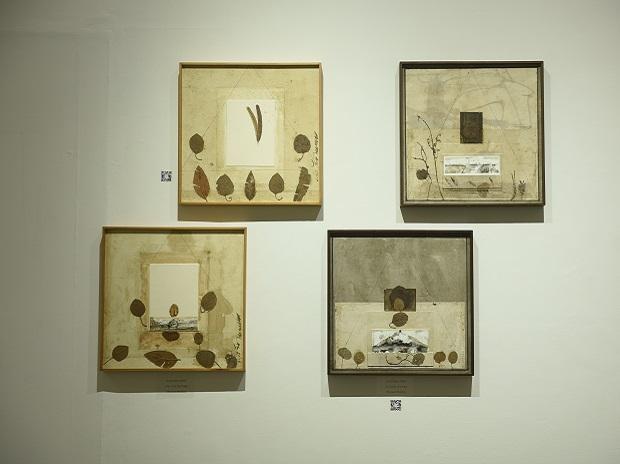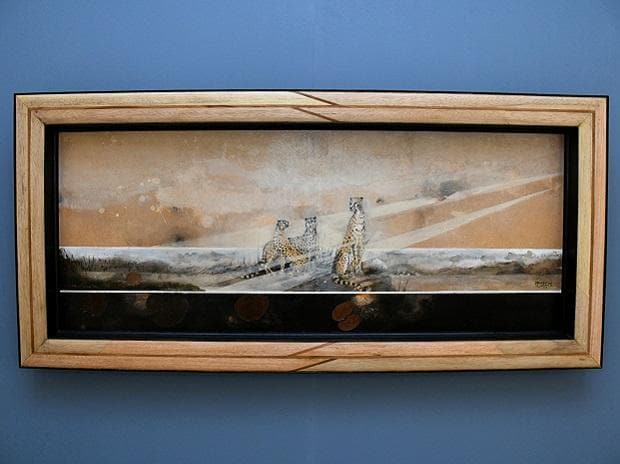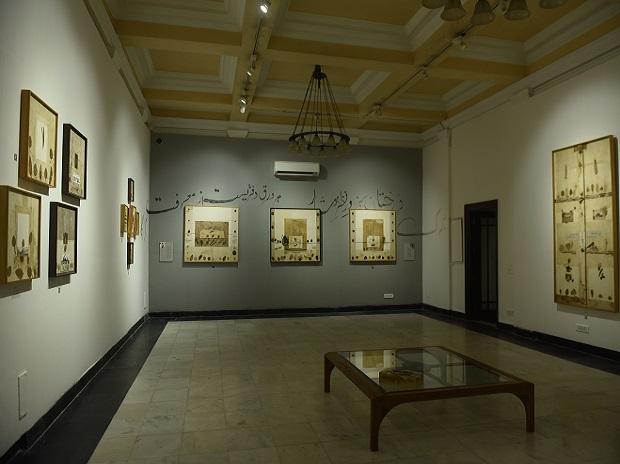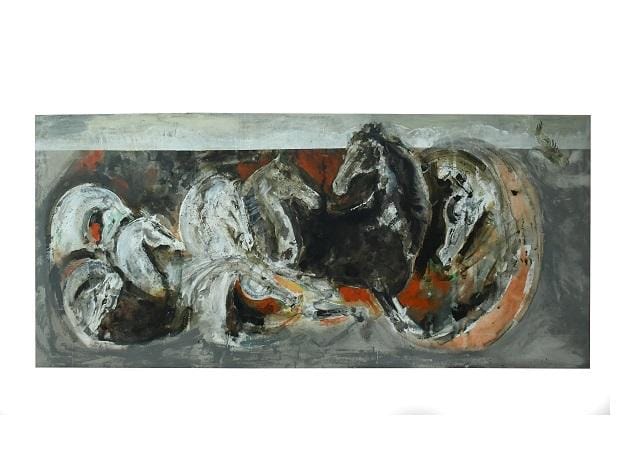This cold January, the walls of Bikaner House in Delhi are alive with frames from the life of the multifaceted Muzaffar Ali.
On display are some 100 artworks spread through 11 sections of this beautiful heritage building, which was once the house of the maharaja of Bikaner and is now a vibrant cultural centre on the India Gate hexagon.
Muzaffar Ali, 78, is a man who has journeyed to many destinations, and his artworks – paintings, collages, installations, furniture – capture five decades of that creative journey. So it is only apt that each of these sections should be called Makaam (destination).
Through these works you see the filmmaker, the poet, the thinker, and the traveller who is captivated by the wonder of nature – with leaves, stones and horses holding a special place in his world. You also get a glimpse of the designer (in another lifetime, Muzaffar Ali was even involved in designing uniforms for the Air India crew and the interiors of its aircraft).

Photo: Shahzid Chauhan
So where does one start the tour of “Muzaffar Ali: Mystic Journeys in Art”?
Perhaps from the gallery of leaves, a symphony in the soothing shades of the earth that could be read as an ode to eternity. The dried leaves and the aged barks, which are central to these paintings, tell you it is autumn, the magic of which the artist is celebrating. Autumn, after all, holds within it the promise of spring.
A self-taught artist and a geology graduate from Aligarh Muslim University, Muzaffar Ali, whose subjects included botany, is clearly a keen observer of nature. The cheetah watching from one of the paintings is just another proof of that.

Muzaffar Ali’s The Cheetahs in Main Art Gallery. (Photo: Shahzid Chauhan)
The House of Kotwara, the couture brand he founded in 1990 and which is named after his home some 160 km from Lucknow, is also referenced in this exhibition through installations in the corridor leading to the room of leaves.
Head to a different wing of Bikaner House and among the first things you encounter is a small painting of his father, “Raja S Sajid Husain of Kotwara with his 1924 Rover outside La Martiniere College, Lucknow”, and the photograph it recreates. On the wall running alongside the wooden staircase near the entrance is another one, this time of the Raja with his 1929 Isotta Fraschini in Scotland.

Maqaam at Bikaner House. (Photo: Shahzid Chauhan)
Now, is it even possible to talk about Muzaffar Ali and not mention Gaman, his 1978 directorial debut that captured the despondent lives of migrants struggling to find a foothold in a big city? Or skip Umrao Jaan (1981) altogether?
So intense is the hangover of these films that curator Uma Nair thought it best to put the Portraits’ section right in the beginning – “so that people can see them and then move on to the many other things Muzaffar Ali is about,” she says, laughing.
So, there is a painting of Umrao Jaan (Rekha), her face and hand glowing in an otherwise dark composition. There’s also Khairun Nissa (Smita Patil from Gaman), her eyes looking down, reminiscent of the film’s last scene when she slowly closes the door after yet another day of a hopeless wait for her migrant, Ghulam Hasan (Farooq Shaikh). And, there is one – a vertical frame – of his muse, his wife Meera.

Awaaz e Ishq. (Photo: Shahzid Chauhan)
Faces are tricky to capture. In the catalogue, Muzaffar Ali writes, “Sometimes by accident I wander into this domain and most often I get lost and trapped in it…. with the fear of losing what I have seen in the face. I don’t want to distort it or take short cuts.”
The artist’s wanderlust also finds a unique expression in the windshields, dashboards and rearview mirrors of cars, which he has painted and turned into collages. All of them in earthy shades – tones he does not wander away from. The car becomes the “lived landscape of life,” as Nair puts it.
In one of the paintings, you can picture him looking ahead through the windscreen at what is to come and also looking back, through the rearview, at what he has left behind – a moment in which both the worlds converge. It’s a gaze of wonder he hopes he never loses.
The landscape series captures the refraction of light, changing the view, altering it or adding new dimensions to it, both for the traveller and the onlooker.
This magnum opus of an exhibition also brings to the world Muzaffar Ali’s furniture and objects created in multiple mediums. The clothes hanger, the chess table, the coffee table, the book covers, the gift cases, the smoker’s chair… each a creative collage.
Muzaffar Ali is a man of few words and many expressions.
His series inspired by the Sufi mystic Rumi, whom he quotes alongside several of his works, is a walk into a world of stillness and self-reflection.
It is in this section that the exhibition’s largest canvas, “Awaaz e Ishq”, is displayed. Part of it was painted in his studio at Kotwara and part of it at Bikaner House last year. The mystical work with horses and falcons unfolded to Rumi’s poetry.
The horse, in its many forms and moods, is the subject of several other of his works. Gentle, powerful, loyal, secretive, spirited, the steed has invited some careful study. “I have had a horse for 12 years,” says Muzaffar Ali. “He is called Barack.”
In the catalogue, the artist writes, “My love for horses began from childhood stories of the battlefield of ‘Karbala’ to the ornate Duldul to the horses I saw on my travels to the many films on horses.”
This is the inspiration for the ‘Karbala series’. It makes for one of the most evocative sections, with sketches and paintings on the purple walls of a room that is filled with the deep voice of Muzaffar Ali reciting a poem of his.
Soaking it all in, a visitor to the exhibition remarks, “One life is not enough for someone like you.” As Muzaffar Ali smiles, Uma Nair, the curator, replies, “He has packed many lives into one.”
“Muzaffar Ali: Mystic Journeys in Art” is on at Bikaner House, New Delhi, till January 21
